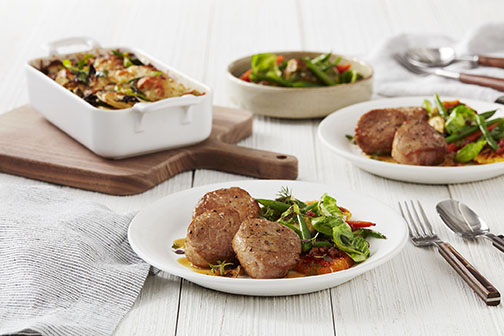
Orange and thyme pork medallions
With Pancetta Roasted Vegetables and Potato & Leek Gratin
These citrus and herb pork medallions pack a flavorful, zesty punch.

Ingredients
1 lb Open Prairie® Natural* Pork tenderloin medallions
1 Tbsp olive oil, divided
½ tsp kosher salt
¼ tsp fresh cracked black pepper
1 ½ tsp minced shallots
½ tsp minced garlic
½ c orange juice
¼ c chicken stock
1 Tbsp butter
2 tsp fresh thyme leaves
1 Tbsp orange zest
4 orange slices, peeled
Instructions
- Pat medallions dry; rub with 2 teaspoons olive oil. Season with salt and pepper.
- In medium-large saute pan, heat 1 teaspoon olive oil over medium-high heat.
- Sear medallions for 5 to 7 minutes on each side or until an internal temperature of 130°F. Set medallions aside.
- Add shallots and garlic to saute pan over medium-high heat; cook 1 to 2 minutes or until tender.
- Add orange juice and chicken stock; cook 5 minutes, scraping pan as liquids reduce.
- When sauce begins to thicken, reduce heat to low. Stir in thyme and butter until incorporated.
- To serve, pour sauce over medallions. Sprinkle with orange zest and garnish with orange slices.
- For Pancetta Roasted Baby Spring Vegetables: Preheat oven to 375°F.
- In medium bowl toss carrots, Brussels sprouts, green beans, olive oil, salt and pepper.
- On oven-safe pan place vegetables; roast 25 to 30 minutes or until lightly browned and tender.
- In small saute pan, fry pancetta over medium-high heat for 7 to 10 minutes or until golden brown.
- In medium bowl, combine vegetables and pancetta; sprinkle dill over top. Serve immediately.
- For Potato & Leek Gratin: Preheat oven to 350°F. Lightly grease 9 x 9-inch pan.
- Leaving root end together, slice leek lengthwise into quarters. Wash leek well to remove all sand and dirt.
- Slice white and light green part of leek against the grain into ¼-inch thick slices.
- In small saute pan, heat olive over low heat. Add leek and garlic; cook 7 minutes or until tender.
- Peel and slice potatoes into ⅛-inch thick slices.
- In medium bowl, combine potatoes, leek mixture, cream, cheeses, salt and pepper, coating each potato slice with the gratin mixture.
- Arrange gratin in pan and place on sheet pan in case some of gratin overflows.
- Bake 1 hour and 25 minutes or until tender and browned. Serve immediately.
Ingredients
Makes: 4 servings
Prep time: 15 minutes
Cook time: 35 minutes
Ingredients:
10 oz baby carrots, trimmed and cut in half lengthwise
8 oz Brussels sprouts, trimmed and cut in half
6 oz green beans, trimmed
1 Tbsp olive oil
1 ¼ tsp kosher salt
¾ tsp fresh cracked black pepper
2 oz pancetta, diced
1 ½ tsp chopped fresh dill
Makes: 4 to 6 servings
Prep time: 15 minutes
Cook time: 1 hour 25 minutes
Ingredients:
1 medium leek
2 tsp olive oil
1 tsp minced garlic
3 lb russet potatoes
1 ½ c heavy cream
3 oz white cheddar cheese, grated
3 oz Gruyere cheese, grated
1 ¼ tsp kosher salt
¾ tsp fresh cracked black pepper
Instructions
Nutritional analysis based on the suggested serving size of main protein dish and ingredients, excluding side items.